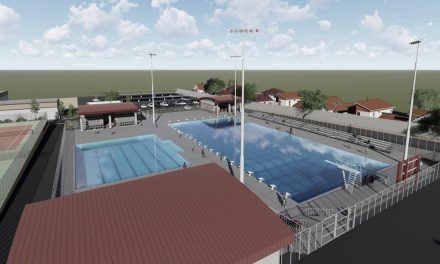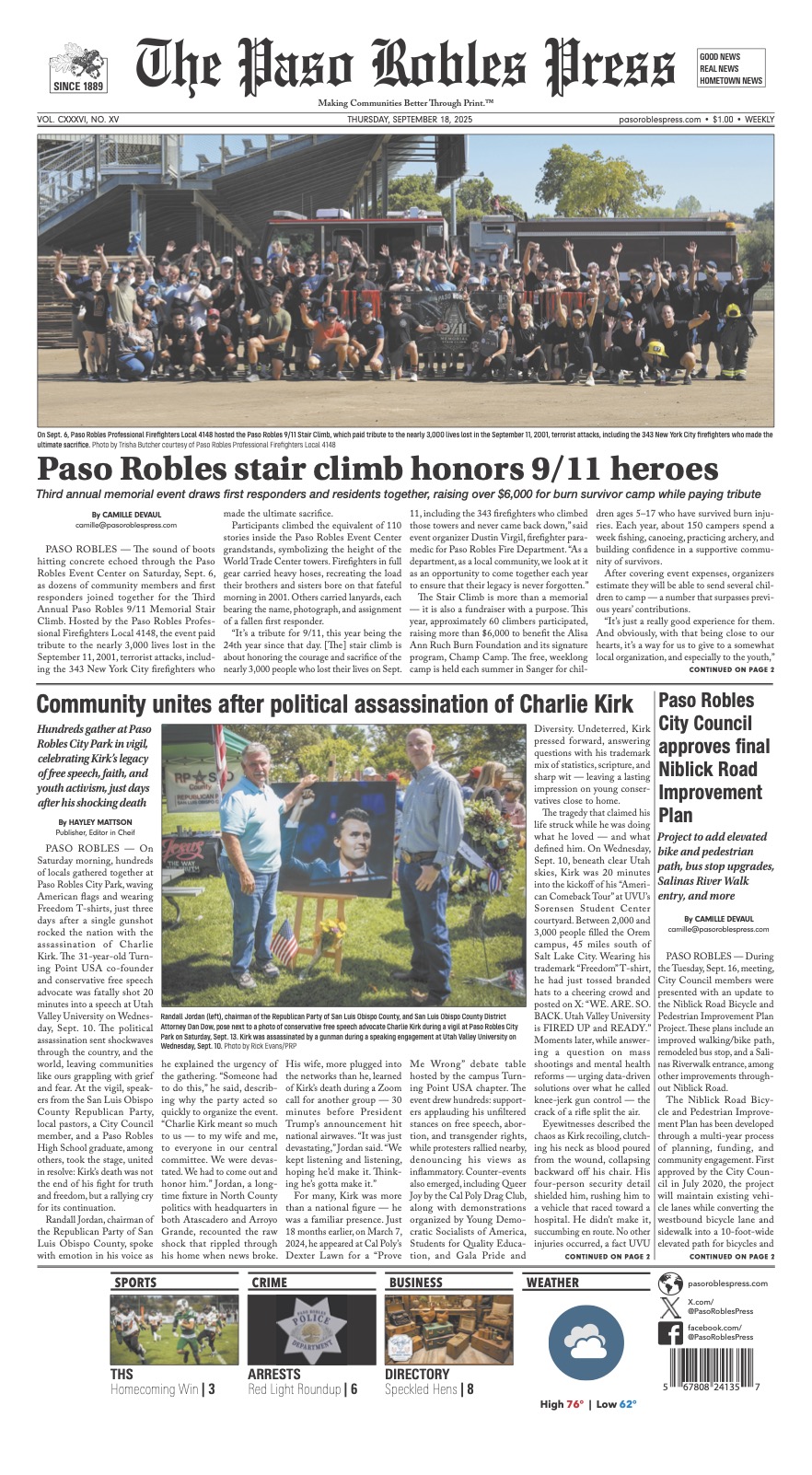Students with special needs and portal-to-portal routes remain supported
In the face of a budget deficit due to stagnant enrollment numbers and a lack of bus drivers, the Paso Robles Joint Unified School District cut a majority of general education school bus routes for next year.
In trying to balance the budget, PRJUSD staff presented several options to the Board the revolved around cutting the District’s transportation program for general education students. The cuts do not affect funding for students with special needs, which schools are mandated by the federal government to provide. The entire busing program relies on a $1.9 million budget with special education comprising $1.2 million of the total. The general education route costs approximately $60,000 per route and $110,000 per special education route.
“One of the things that we need to take away from this whole discussion is that at the end of tonight, whatever option we choose, we will continue to provide transportation with students with disabilities,” Chief Business Officer Brad Pawlowski said.
At the Feb. 25 meeting, the Board reviewed options and finally came to a 6-1 decision, Boardmember Christopher Arend dissenting, to approve the proposed Option 2b with stipulations. The decision followed Arend’s motion to approve another option that would eliminate all general education transportation and save the District approximately $270,000 failed to pass with (1-6).
The board’s decision removes eight of 12 of the general education bus routes an only provides transportation for high school students. Almost 900 children will be affected by the cuts that trim off approximately $90,000 from the District’s budget.
To save money and time, one bus would be parked out in the Heritage Ranch area. It would provide general education transportation for 56 students with an option to pick up additional kids at 17th and Vine streets when not at full capacity. The plan keeps the two San Miguel High School busses and adds a portal-to-portal bus for Virginia Peterson, Cuesta College, Flamson Middle School, and Paso Robles High School. The stipulation added to the option was additional portal-to-portal routes added as drivers become available. The District agreed to consult with the bus drivers to work out the most cost-effective routes possible.
Bus drivers have raised concerns about overburdening the schoolyards, saying that parents would be forced to drop their kids off early before driving to work.
“It is difficult for us as drivers to know the faces that will be left out of the loop of transportation, the hardship it will place on the outer areas of the North County,” PRJUSD bus driver Bonney Bruen wrote in an email to Paso Robles Press. “Yes, we would like to keep our positions as well, but those of us that enjoy what we do, do it for the kids.”
Bus drivers applauded the decision and later told the Paso Robles Press that they were delighted that the Board decided to work with the drivers in finding the best route and provide services with the most children possible.
“I am ever hopeful that we can come up with a creative solution that meets different perspectives,” Superintendent Curt Dubost. “I am very cognizant of my number one role, and the number one goal of the board this year, was to restore confidence in the district in the way we do things.”
Adding to the destressed budget is the increase in the amount the District has to pay to California Public Employees’ Retirement System (CalPERS). With the increase in PERS, the district benefits cost grew approximately $120,000 in the past five years.
Board member Joel Peterson asked about the increase in indirect services. In the 2016/17 budget, these services showed a surplus of $1,851. However, the amount jumped to $11,830 in the 2017/2018 budget and currently sits at over $129,000 for the 2019/2020 budget, but was down from the previous year of $194,44. Pawlowski said that part of the cost comes from paying for fuel and parts for the vehicles and some from indirect costs charges from the accounting department. However, Pawlowski could not account for the increase from the past five years saying that he was not part of the budgeting process.
The District is also considering the approval of a 20-vehicle financed purchase for $15,974.37 per month for 60 months with term commencement at 12 months from lease execution. The proposal included two Sourcewell Contract one for procuring 16 new ten-passenger Ford vans and four new MobilityWorks vans at $37,562.94 and $62,748.99, respectively.
At the Jan. 25 special board meeting, district staff presented vehicle purchase options to address the issues facing the District’s aging white fleet. The vehicles would be utilized to provide transportation for extra-curricular and sports events.
Pawlowski requested the item be pulled from the discussion. He said that staff recommended the District open the bid to the public that would allow the opportunity for more competitive bidding. Pawlowski said he hopes to bring the matter before the Board again in a few weeks.
“Originally, staff had recommended that we use a piggy-back agreement — which is a joint powers cooperative purchasing for these 20 vans,” said Pawlowski. “We feel that would be a better process and include local vendors even more so if we were to do a public bid, so we are in the process of doing that.”
In the face of a budget deficit due to stagnant enrollment numbers and a lack of bus drivers, the Paso Robles Joint Unified School District cut a majority of general education school bus routes for next year.
In trying to balance the budget, PRJUSD staff presented several options to the Board the revolved around cutting the District’s transportation program for general education students. The cuts do not affect funding for students with special needs, which schools are mandated by the federal government to provide. The entire busing program relies on a $1.9 million budget with special education comprising $1.2 million of the total. The general education route costs approximately $60,000 per route and $110,000 per special education route.
“One of the things that we need to take away from this whole discussion is that at the end of tonight, whatever option we choose, we will continue to provide transportation with students with disabilities,” Chief Business Officer Brad Pawlowski said.
At the Feb. 25 meeting, the Board reviewed options and finally came to a 6-1 decision, Boardmember Christopher Arend dissenting, to approve the proposed Option 2b with stipulations. Arend’s motion to approve Option that would eliminate all general education transportation and save the District approximately $270,000 failed to pass with (1-6).
The decision removes eight of 12 of the general education bus routes an only provides transportation for high school students. Almost 900 children will be affected by the cuts that trim off approximately $90,000 from the District’s budget.
To save money and time, one bus would be parked out in the Heritage Ranch area. It would provide general education transportation for 56 students with an option to pick up additional kids at the 17th and Vine stop when not at full capacity. The plan keeps the two San Miguel High School Busses and adds a portal to portal bus for Virginia Peterson, Cuesta College, Flamson Middle School, and Paso Robles High School. The stipulation added to the option was an additional portal to portal routes added as drivers become available. The District agreed to consult with the bus drivers to work out the most cost-effective routes possible.
Bus drivers have raised concerns about overburdening the schoolyards saying that parents would be forced to drop their kids off early before driving to work.
“It is difficult for us as Drivers to know the faces that will be left out of the loop of transportation, the hardship it will place on the outer areas of the North County,” PRJUSD bus driver Bonney Bruen wrote in an email to Paso Robles Press. “Yes, we would like to keep our positions as well, but those of us that enjoy what we do, do it for the kids.”
Bus drivers applauded the decision and later told the Paso Robles Press that they were delighted that the Board decided to work with the drivers in finding the best route and provide services with the most children possible.
“I am ever hopeful that we can come up with a creative solution that meets different perspectives,” Superintendent Curt Dubost, “I am very cognizant of my number one role, and the number one goal of the board this year, was to restore confidence in the district in the way we do things.”
Adding to the destressed budget is the increase in the amount the District has to pay to California Public Employees’ Retirement System (CalPERS). With the increase in PERS, the district benefits cost grew approximately $120,000 in the past five years.
Board member Joel Peterson asked about the increase in indirect services. In the 2016/17 budget, these services showed a surplus of $1,851. However, the amount jumped to $11,830 in the 2017/2018 budget and currently sits at over $129,000 for the 2019/2020 budget, but was down from the previous year of $194,44. Pawlowski said that part of the cost comes from paying for fuel and parts for the vehicles and some from indirect costs charges from the accounting department. However, Pawlowski could not account for the increase from the past five years saying that he was not part of the budgeting process.
The District is also considering the approval of a 20-vehicle financed purchase for $15,974.37 per month for 60 months with term commencement at 12 months from lease execution. The proposal included two Sourcewell Contract one for procuring 16 new ten-passenger Ford vans and four new MobilityWorks vans at $37,562.94 and $62,748.99, respectively.
At the Jan. 25 special board meeting 25, 2020, district staff presented vehicle purchase options to address the issues facing the District’s aging white fleet. The vehicles would be utilized to provide transportation for extra-curricular and sports events.
Pawlowski requested the item be pulled from the discussion. He said that staff recommended the District open the bid to the public that would allow the opportunity for more competitive bidding. Pawlowski said he hopes to bring the matter before the Board again in a few weeks
“Originally, staff had recommended that we use a piggy-back agreement which is a joint powers cooperative purchasing for these 20 vans,” said Pawlowski, “we feel that would be a better process and include local vendors even more so if we were to do a public bid, so we are in the process of doing that.”















